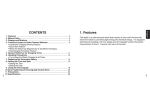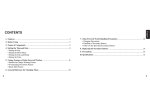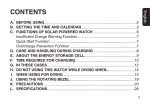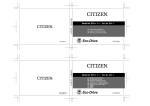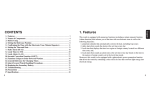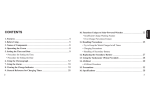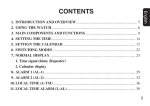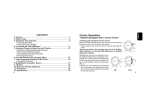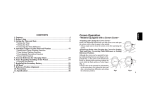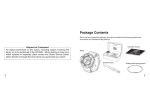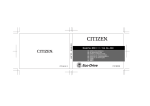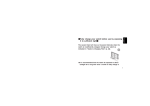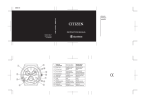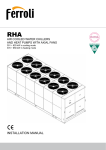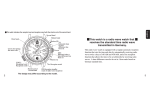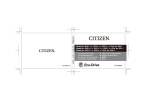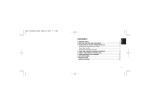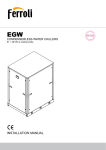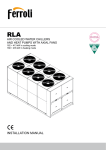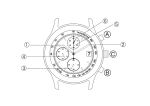Download Citizen H57 Specifications
Transcript
1. 2. 3. 4. Features ..................................................................................................................... 3 Before Using ............................................................................................................. 4 Names of Components ............................................................................................. 5 Functions Unique to Solar-Powered Watches ....................................................... 6 • Insufficient Charge Warning Feature • Quick Start Feature • When Watch has Stopped due to Insufficient Charging • Over Charge Prevention Feature 5. General Reference for Charging Times ............................................................... 11 6. Solar-Powered Watch Handling Precautions ...................................................... 12 • Try to keep the watch charged at all times 7. Replacing the Secondary Battery ......................................................................... 15 8. Setting the Time and Date ..................................................................................... 16 • Setting the Time • Setting the Date 9. Using the Chronograph ......................................................................................... 19 10. Zeroing the Chronograph Second Hand .............................................................. 21 11. Using the Tachymeter (When Provided) ............................................................. 23 12. Precautions ............................................................................................................. 24 13. Specifications .......................................................................................................... 30 2 1. Features This watch is a solar-powered watch that contains a solar cell in its face that drives the watch by converting light energy into electrical energy. It is also equipped with numerous functions including a 24 hour display and a chronograph function capable of timing for up to 30 minutes in 1 second units. English CONTENTS 3 2. Before Using This watch is a solar-powered watch. Please fully charge the watch before using by exposing it to light by referring to “5. General Reference for Charging Times”. A secondary battery is used in this watch to store electrical energy. This secondary battery is a clean energy battery that does not contain mercury or other toxic substances. Once fully charged, the watch will continue to run for about 5 months without additional charging. <Proper Use of this Watch> To use this watch comfortably, make sure to charge it before it stops running completely. Since there is no risk of overcharging no matter how much the watch is charged (Over Charge Prevention Feature), it is recommended that the watch be charged every day. 3. Names of Components Chronograph second hand Minute hand Hour hand Button (A) 24 hour hand Crown Chronograph minute hand Button (B) Second hand Date The design may vary depending on the model. 4 5 4. Functions Unique to Solar-Powered Watches [Normal Time Display] When the watch becomes insufficiently charged, the watch display changes as shown below. When the watch has changed from normal hand movement to the insufficient charge warning feature, this indicates that that the watch is insufficiently charged. Allow light to shine on the solar cell until the watch returns to 1-second interval movement. Even after the watch has returned to 1-second interval movement, sufficiently charge the watch by exposing it to light by referring to “5. General Reference for Charging Times” to ensure that the watch is used comfortably. 6 [Insufficient Charge Warning Display] The second hand switches from 1-second interval movement to 2-second interval movement When the watch becomes insufficiently charged as a result of not being exposed to light [Stopped] All of the hands stop moving If the watch is continued to be used without charging When the watch is charged by exposing to light 2-second interval movement continues if the watch is insufficiently charged 2 seconds 2 seconds The second hand begins 2-second interval movement when the watch is charged by allowing light to shine on the solar cell. However, since the watch has stopped as a result of being insufficiently charged, the time is incorrect. Sufficiently charge the watch until the second hand begins 1-second interval movement and then reset the time before using. 7 [Insufficient Charge Warning Feature] [Quick Start Feature] Switches from 1-second interval movement (normal movement) to 2-second interval movement When light (approx. 500 lx) shines on the solar cell after the watch has stopped as a result of being insufficiently charged, the second hand begins 2-second interval movement and the watch starts to run after about 10 seconds (the time until the watch starts to run varies according to the model). However, please note that the watch will end up stopping again if the solar cell is blocked from the light since the watch will again become insufficiently charged. When the capacity of the secondary battery becomes low as a result of light not shining on the solar cell, the second hand switches from 1-second interval movement (normal movement) to 2-second interval movement. Although the watch continues to run normally at this time, the watch ends up stopping if it remains insufficiently charged for about 5 days after the start of 2-second interval movement. Sufficiently charge the watch by exposing to light so that the second hand returns to 1-second interval movement. [When Watch has Stopped due to Insufficient Charging] 2 seconds 2 seconds Notes: • When chronograph timing is in progress, timing is interrupted and the chronograph second hand is reset to the 0 seconds position. • The chronograph minute hand stops at any arbitrary position. Press button (B) to return to the 0 minutes position. 8 When the capacity of the secondary battery has been depleted as a result of light not shining on the solar cell, the watch becomes insufficiently charged and stops. When light shines on the solar cell, the Quick Start Feature is activated and the second hand begins 2-second interval movement. Sufficiently charge the watch by exposing to light until the second hand returns to 1-second interval movement. Note: • Even though the watch starts to run, since the watch has previously stopped as a result of being insufficiently charged, the time is incorrect. Reset the time before using the watch. 9 [Over Charge Prevention Feature] When the secondary battery becomes fully charged as result of light shining into the watch dial (solar cell), the over charge prevention feature is activated automatically to prevent the battery from being charged further. This prevents the performance of the solar cell and secondary battery from deteriorating no matter how much the watch is charged, and lets you expose the watch to light without worrying about overcharging. 5. General Reference for Charging Times The time required for charging varies according to the model of the watch (color of the dial, etc.). The following times are shown below to serve only as a reference. * Charging time refers to the amount of time the watch is continuously exposed to light. Charging time Approx. charging time for 1 day of operation Approx. charging time from the stopped state until 1-second interval movement Approx. charging time from the stopped state until fully charged 3 hours 25 hours ----- 1.5 hours 12 hours ----- 30 minutes 4.5 hours 80 hours 10,000 Outdoors, cloudy weather 9 minutes 2 hours 25 hours summer, under 100,000 Outdoors, direct sunlight 3 minutes 45 minutes 11 hours Illuminance (lux) Environment 500 Inside an ordinary office cm (24-28 in) under a 1,000 60-70 fluorescent lamp (30 W) cm (8 in) under a 3,000 20 fluorescent lamp (30 W) Full charging time: Time required for charging the watch from the stopped state to fully charged. Charging time for 1 day of operation: Time required for charging the watch to run for 1 day at 1-second interval movement. 10 11 6. Solar-Powered Watch Handling Precautions [Try to keep the watch charged at all times.] Please note that if you frequently wear long sleeves, the watch can easily become insufficiently charged because of being hidden and not exposed to light. When you take the watch off, try to place in as bright a location as possible so that it will always be charged and continue to run properly at all times. Charging Precautions • Avoid charging the watch at high temperatures (about 60°C / 140°F or higher) since allowing the watch to reach a high temperature during charging can cause a malfunction. 12 Examples: • Charging by placing the watch too close to a light source that may become hot such as an incandescent lamp or halogen lamp, or charging by placing the watch on an automobile dashboard that can easily reach a high temperature. • When charging the watch with an incandescent lamp, halogen lamp or other light source that may reach a high temperature, always make sure to place the watch at least 50 cm (20 in) away from the light source to prevent the watch from reaching a high temperature. Handling of Secondary Battery • Never attempt to remove the secondary battery from the watch. • If the secondary battery must unavoidably be removed, store it out of the reach of small children to prevent accidental swallowing. • If the secondary battery should happen to be swallowed, consult a physician immediately and seek medical attention. 13 Only Use the Specified Secondary Battery • Never use a secondary battery other than the genuine secondary battery used in this watch. Even if another type of secondary battery is installed in the watch, the watch structure does not permit its operation. In cases in which a different secondary battery such as a silver battery is forcibly installed in the watch and charged, overcharging may occur that will eventually cause the secondary battery to rupture. This can result in the risk of the watch being damaged or injury to the wearer. • When the secondary battery is replaced, always make sure to use the specified secondary battery. 14 7. Replacing the Secondary Battery Unlike ordinary silver batteries, the secondary battery used in this watch does not have to be periodically replaced due to repeated charging and discharging. 15 8. Setting the Time and Date If the crown of your watch is of the screw-lock type, operate the crown after first loosening the screw locking mechanism by turning the crown to the left. When finished operating the crown, turn the crown to the right while pushing in after having returned it to the normal position and tighten securely. Hour hand Minute hand Normal position Time correction position Second hand 16 24 hour hand <Helpful Hint for Setting the Time Accurately> After first stopping the second hand at the 0 seconds position, advance the minute hand 4-5 minutes past the correct time and then turn it back to the correct time. Then push in the crown in synchronization with a telephone or other time service to accurately set the time. [Setting the Time] 1. Pull the crown out to the time correction position when the second hand reaches the 0 seconds position. 2. Turn the crown to set the time. • The 24 hour hand moves in coordination with the hour hand. Pay attention to AM and PM when setting the time. 3. Securely push in the crown to the normal position in synchronization with a telephone or other time service. 17 [Setting the Date] 1. Pull the crown out the date correction position. 2. Turn the crown to the right to set the date. • Nothing will happen if the crown is turned to the left. • If the date is set when the time on the watch Date is between about 9:00 PM and 1:00 AM, the correction date will not change on the following day. position If this happens, reset the date after Date temporarily moving the hands to a time outside the above time period. • The date operates based on a 31-day month. It is therefore necessary to correct the date by operating the crown to the first day of the following month in months with less than 31 days (months with 30 days and February). • The date changes around 12:00 AM. 3. Once the date has finished being set, return the crown to the normal position. 18 9. Using the Chronograph * When using the chronograph, begin timing after first making sure that the chronograph minute hand has returned to the 00 minutes position. * If the chronograph minute hand is not at the 00 minutes position, slowly press button (B) until it returns to the 00 minutes position. [Chronograph Timing] This chronograph measures and displays time up to 30 minutes in 1 second units. Each of the chronograph hands stop when 30 minutes has elapsed. Chronograph minute hand [Correct 00 minutes position of chronograph minute hand] Chronograph second hand Button (A) Button (B) 19 <Timing Procedure> 1. Press button (A) to start timing. • The chronograph repeatedly starts and stops each time button (A) is pressed. 2. Press button (B) to reset the chronograph to 0 seconds. (A) (A) Reset Timing (B) Stop (A) (B) Note: • Do not subject the watch to strong impacts during chronograph timing. If the watch is subjected to a strong impact during chronograph timing or after it has stopped automatically after 30 minutes have elapsed, the chronograph minute hand may shift position. If this happens, use the chronograph after first resetting by pressing button (B). 20 10. Zeroing the Chronograph Second Hand If the chronograph second hand does not return to the 0 seconds position when the chronograph has been reset or if the chronograph second hand has shifted position as a result of the watch being subjected to a strong impact, zero the chronograph second hand by performing the procedure described below. • If the crown of your Chronograph watch is of the screwminute hand Chronograph lock type, operate the second hand crown after first loosening the screw Button (A) locking mechanism. • The chronograph second hand cannot be zeroed if Time correction the insufficient charge Button position warning feature has been (B) activated (while the second hand is moving 21 [Zeroing the Chronograph Second Hand] The tachymeter feature is used to measure traveling speed such as that of an automobile. In the case of this watch, the average speed can be approximately determined for a certain distance by measuring how many seconds it takes to travel 1 kilometer (measuring range: maximum 60 seconds). To determine average speed, start the chronograph simultaneous to the start of measurement. Stop the chronograph when the vehicle has traveled 1 kilometer. An approximation of the average speed over that distance can be determined by the position of the chronograph second hand at that time. 60 TAC HY Chronograph second hand ER ET M 1. Pull the crown out to the time correction position. 2. When button (A) is pressed for at least 3 seconds and released, the watch enters the chronograph second hand 0 position correction mode. Press button (A) again to set the chronograph second hand to the 0 seconds position. • The chronograph second hand advances by one second (clockwise rotation) each time button (A) is pressed. • Pressing button (A) continuously causes the chronograph second hand to advance rapidly. 3. Once the chronograph second hand has been zeroed, reset the time and return the crown to the normal position. 4. Check that the chronograph minute hand has been reset to the 0 position by pressing button (B). 11. Using the Tachymeter (When Provided) 80 at 2-second intervals due to the watch being insufficiently charged). Zero the chronograph hand after first sufficiently charging the watch and confirming that the second hand has returned to 1-second interval movement. 120 22 Tachymeter Example: If it takes 45 seconds to travel 1 kilometer, then the average speed over that distance is 80 kilometers/hour. 23 For correct use within the design limits of the watch, confirm the level of waterresistance of your watch, as indicated on the dial and case, and consult the table. 12. Precautions CAUTION: Water-resistance performance Examples of use There are several types of water-resistant watches, as shown in the following table. The unit "bar" is roughly equal to 1 atmosphere. * WATER RESIST(ANT) xx bar may also be indicated as W.R. xx bar. Indication 24 Dial Case (case back) Specifications Minor exposure to water (washing face, rain, etc.) Moderate exposure to water (washing, kitchen work, swimming, etc.) Marine sports (skin diving) Scuba diving (with air tank) Operation of the crown or button with moisture visible WATER RESIST or no indication WATER RESIST(ANT) Water-resistant to 3 atmospheres OK NO NO NO NO WR 50 or WATER RESIST 50 WATER RESIST(ANT) 5 bar or WATER RESIST(ANT) Water-resistant to 5 atmospheres OK OK NO NO NO WR 100/200 or WATER RESIST 100/200 WATER RESIST(ANT) 10bar/20 bar or WATER RESIST(ANT) Water-resistant to 10/20 atmospheres OK OK OK NO NO 25 • Water-resistance for daily use (to 3 atmospheres): This type of watch is water-resistant to minor exposure to water. For example, you may wear the watch while washing your face; however, it is not designed for use underwater. • Upgraded water-resistance for daily use (to 5 atmospheres): This type of watch is waterresistant to moderate exposure to water. You may wear the watch while swimming; however, it is not designed for use while skin diving. • Upgraded water-resistance for daily use (to 10/20 atmospheres): This type of watch may be used for skin diving; however, it is not designed for scuba or saturated diving using helium gas. • If seawater enters the watch, place the watch in a box or plastic bag and immediately take it in for repair. Otherwise, pressure inside the watch will increase, and parts (crystal, crown, buttons, etc.) may come off. CAUTION: Keep your watch clean. CAUTION • Leaving dust and dirt deposited between the case and crown may result in difficulty in pulling the crown out. Rotate the crown while in its normal position, from time to time, to loosen dust and dirt and then brush it off. • Dust and dirt tend to be deposited in gaps in the back of the case or band. Deposited dust and dirt may cause corrosion and soil your clothing. Clean the watch occasionally. • Be sure to use the watch with the crown pressed in (normal position). If your watch has a screw-lock type crown, be sure to tighten the crown completely. • Do NOT operate the crown or button with wet fingers or when the watch is wet. Water may enter the watch and compromise water-resistance. • If the watch is used in seawater, rinse with fresh water afterward and wipe with a dry cloth. • If moisture has entered the watch, or if the inside of the crystal is fogged up and does not become clear within a day, immediately take the watch to your dealer or Citizen Service Center for repair. Leaving the watch in such a state will allow corrosion to form inside. Cleaning the Watch • Use a soft cloth to wipe off dirt, perspiration and water from the case and crystal . • Use a soft, dry cloth to wipe off perspiration and dirt from the leather band. • To clean a metal, plastic, or rubber watchband, wash away dirt with mild soap and water. Use a soft brush to remove dust and dirt jammed in the gaps in the metal band. If your watch is not water-resistant, take it to your dealer. NOTE: Avoid using solvents (thinner, benzine, etc.), as they may mar the finish. 26 27 WARNING: Handling of the battery • Keep the battery out of the reach of small children. If a child swallows the battery, contact a physician immediately. CAUTION: Replacing the battery • For replacement of the battery, take your watch to your dealer or Citizen Service Center. • Replace the battery as soon as possible if the service life of the battery has expired. Leaving a depleted battery in the watch may result in leakage, which can damage the watch severely. CAUTION: Operating environment • Use the watch within the operating-temperature range specified in the instruction manual. Using the watch where temperatures are outside the specified range, may result in deterioration of functions or even stoppage of the watch. • Do NOT use the watch in places where it is exposed to high temperature, such as in a sauna. Doing so may result in a skin burn. • Do NOT leave the watch in a place where it is exposed to high temperature, such as the glove compartment or dash-board of a car. Doing so may result in deterioration of the watch, such as deformation of plastic parts. • Do NOT place the watch close to a magnet. 28 Timekeeping will become inaccurate if you place the watch close to magnetic health equipment such as a magnetic necklace or a magnetic latch of a refrigerator door or handbag clasp or the earphone of a mobile phone. If this has occurred, move the watch away from the magnet and reset the time. • Do NOT place the watch close to household appliances that generate static electricity. Timekeeping may become inaccurate if the watch is exposed to strong static electricity, such as is emitted from a TV screen. • Do NOT subject the watch to a strong shock such as dropping it onto a hard floor. • Avoid using the watch in an environment where it may be exposed to chemicals or corrosive gases. If solvents, such as thinner and benzine, or substances containing such solvents come in contact with the watch, discoloration, melting, cracking, etc. may result. If the watch comes in contact with mercury used in thermometers,the case, band or other parts may become discolored. Periodical inspections Your watch needs inspection once in every two or three years for safety and long use. To keep your watch water-resistant, the packing needs to be replaced regularly. Other parts need to be inspected and replaced if necessary. Ask for Citizen geuine parts upon replacement. 29 13. Specifications 1. Model: H57* 2. Type: Analog solar-powered watch 3. Timekeeping accuracy: Within ±15 seconds per month on average (when worn at normal temperatures of +5 °C to +35°C / 41°F to 95°F) 4. Crystal oscillation frequency: 32,768 Hz 5. Operating temperature range: -10°C to +60°C / 14°F to 140°F 6. Display functions: • Time: 24 hour display, hours, minutes, seconds • Calendar: Date (with rapid correction function) 7. Additional functions: • Chronograph (timing for up to 30 minutes in 1 second units) • Insufficient charge warning feature • Quick start feature • Over charge prevention feature 30 8. Continuous Operating Times • Time until watch stops without charging after being fully charged: Approx. 5 months (the continuing operating time may vary depending on how often the chronograph and other functions are used) • Time from 2-second interval movement to stopped: Approx. 5 days 9. Battery: Secondary battery, 1 * Specifications are subject to change without notice. 31















